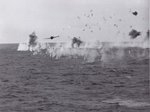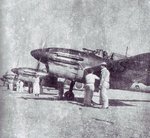- Thread starter
- #41
When the Pacific War exploded in all its fury on December 7, 1941, the Nakajima B5N2 carrier torpedo bomber was the best in service with any of the world's navies. One hundred and forty-four aircraft of this type participated in the Pearl Harbor attack as torpedo and level bombers, and they crippled the American Pacific Fleet's battleship force. During the following twelve months, carrier-based B5N2s were to participate in sinking three American aircraft carriers, while land- and carrier-based B5N2s supported Japanese amphibious landings on all fronts. But by 1944, the Kate, as it was code-named by the Allies, was plainly obsolete, and so it finished out the war in second-line units, mainly as an anti-submarine patrol plane. The Japanese Navy never regarded its B4Y1 biplane torpedo bomber (a contemporary of the essentially similar Fairey Swordfish) as anything other than a stop-gap type, because they wanted a monoplane torpedo bomber with performance more compatible with that of the Mitsubishi A5M carrier fighter (which see). They issued, in 1935, a specification calling for a single-engined monoplane "carrier attack bomber" (as the Japanese termed torpedo bombers). The requirements called for: (1) a wingspan of less than 52 ½ ft. with provision for hydraulic wing folding to reduce the plane's span to no more than 24 ft. 7 9/32 in.; (2) an armament of one 1,764-lb. torpedo and a single rearward-firing 7.7mm machine gun for protection; (3) a maximum speed of 207 mph at 6,560 ft.; (4) a normal endurance of 4 hours or a maximum of 7 hours at 155 mph; (5) a normal crew of three; and (6) either a Nakajima Hikari or Mitsubishi Kinsei radial engine.
Katsuji Nakamura's design team at Nakajima created a beautifully clean low-wing monoplane with a hydraulically-operated retracting undercarriage. The large wing folded upwards, and the hinging points were so arranged that the wingtips overlapped one another when folded above the cockpit. When compared to the large wing, the fuselage seemed oddly small, but it was kept relatively short at 33 ft. 9 ½ in. to fit on the Navy's standard carrier elevators. Other innovations on the Type K, as the company named its creation, were Fowler flaps and a variable-pitch propeller. Powered by the Nakajima Hikari 2 nine-cylinder radial engine, the prototype, given the official designation B5N1, first flew in January 1937. Hydraulic-system difficulties marred the initial flight tests, but the troubles were soon fixed, and the JNAF was particularly pleased with the B5N1's speed, which at 230 mph exceeded the requirement by a comfortable margin.But they were worried that the many technical innovations being introduced by the new aircraft would make it excessively hard to maintain under operational conditions. Nakajima accordingly simplified the second prototype, changing the Fowler flaps to more conventional types and replacing the hydraulic wing-folding mechanism with a manual one. It also had a newer Hikari 3 engine with a constant-speed propeller-the first ever fitted to a production Japanese naval plane of any type-and integral wing fuel tanks with increased capacity. In this form the B5N1 easily won the competition with Mitsubishi's B5M1, and it went into production in November of 1937 as the Navy Type 97 Carrier Attack Bomber Model 11 (B5N1 Model 11).
Carrier qualification trials were carried out at the same time the new bomber was flying its first combat missions in China in the spring of 1938. Armed with bombs, the B5N1 was used as a single-engined level bomber, in a fashion similar to a twin-engined machine. The observer, who was seated between the pilot and the rear gunner/radio operator, was also the bombardier during these missions; he would aim the bombs using a pair of small folding doors in the floor of the fuselage to see his target. Covered by A5M fighters, the B5N1 was a success despite its lack of protection for the crew and fuel and its modest defensive armament of a single 7.7mm machine gun. No major modifications were necessary for China operations, and the only minor change made was to add a mast antenna to replace the trailing antenna. But the JNAF was aware that there would be other opponents than the Chinese, and so in 1939 they instructed Nakajima to develop a better-performing variant of the B5N1. The B5N2 Model 12, or Type 97 Carrier Attack Bomber Model 12, first flew in December 1939; it was externally similar to the older variant aside from its engine, a Nakajima Sakae 11 fourteen-cylinder radial. A tighter-fitting cowling was used, to improve pilot view and reduce drag, and a small hub was fitted to the propeller to further reduce drag and improve the engine cooling. Oddly the B5N2 was not much faster than the B5N1 in spite of the 36% increase in power, but the Navy was pleased, as the Sakae was more reliable than the Hikari, and the B5N2 would fly most of its missions over long stretches of water.
Katsuji Nakamura's design team at Nakajima created a beautifully clean low-wing monoplane with a hydraulically-operated retracting undercarriage. The large wing folded upwards, and the hinging points were so arranged that the wingtips overlapped one another when folded above the cockpit. When compared to the large wing, the fuselage seemed oddly small, but it was kept relatively short at 33 ft. 9 ½ in. to fit on the Navy's standard carrier elevators. Other innovations on the Type K, as the company named its creation, were Fowler flaps and a variable-pitch propeller. Powered by the Nakajima Hikari 2 nine-cylinder radial engine, the prototype, given the official designation B5N1, first flew in January 1937. Hydraulic-system difficulties marred the initial flight tests, but the troubles were soon fixed, and the JNAF was particularly pleased with the B5N1's speed, which at 230 mph exceeded the requirement by a comfortable margin.But they were worried that the many technical innovations being introduced by the new aircraft would make it excessively hard to maintain under operational conditions. Nakajima accordingly simplified the second prototype, changing the Fowler flaps to more conventional types and replacing the hydraulic wing-folding mechanism with a manual one. It also had a newer Hikari 3 engine with a constant-speed propeller-the first ever fitted to a production Japanese naval plane of any type-and integral wing fuel tanks with increased capacity. In this form the B5N1 easily won the competition with Mitsubishi's B5M1, and it went into production in November of 1937 as the Navy Type 97 Carrier Attack Bomber Model 11 (B5N1 Model 11).
Carrier qualification trials were carried out at the same time the new bomber was flying its first combat missions in China in the spring of 1938. Armed with bombs, the B5N1 was used as a single-engined level bomber, in a fashion similar to a twin-engined machine. The observer, who was seated between the pilot and the rear gunner/radio operator, was also the bombardier during these missions; he would aim the bombs using a pair of small folding doors in the floor of the fuselage to see his target. Covered by A5M fighters, the B5N1 was a success despite its lack of protection for the crew and fuel and its modest defensive armament of a single 7.7mm machine gun. No major modifications were necessary for China operations, and the only minor change made was to add a mast antenna to replace the trailing antenna. But the JNAF was aware that there would be other opponents than the Chinese, and so in 1939 they instructed Nakajima to develop a better-performing variant of the B5N1. The B5N2 Model 12, or Type 97 Carrier Attack Bomber Model 12, first flew in December 1939; it was externally similar to the older variant aside from its engine, a Nakajima Sakae 11 fourteen-cylinder radial. A tighter-fitting cowling was used, to improve pilot view and reduce drag, and a small hub was fitted to the propeller to further reduce drag and improve the engine cooling. Oddly the B5N2 was not much faster than the B5N1 in spite of the 36% increase in power, but the Navy was pleased, as the Sakae was more reliable than the Hikari, and the B5N2 would fly most of its missions over long stretches of water.























































